3D Body Scanning
The advent of 3D scanning technology has impacted many industries. One particular type of scanner that has found usage in industries like entertainment, apparel, fitness, and medicine is the 3D body scanner. These scanners have been commercially available since the 1990s. The capability of the scanner to capture a 3D image of a full human body in a few seconds has led to a variety of applications, from creating 3D-printed figurines to technological advances in medicine. Some of the popular uses of this technology include: - Creating realistic models of people for 3D printing, like in the video below, '3D scanning your body using smartphone camera|3D printing & cloning services' - Tracking body changes (by gyms, fitness experts, and athletes) to achieve fitness goals - Creating realistic animations for the entertainment and gaming industry, e.g., film studios use 3D body scanners to capture actors' bodies as ‘digital doubles.’ - Obtaining accurate measurements of bodies/body parts for prosthetics or cosmetic surgery or calculating chemotherapy doses - Mobile body scanning apps for ease in online shopping
The following video explains how to scan any object or human body by using a normal smartphone.
Source. TevasTop comm. (2018)
3D Body Scanning in the Apparel Industry
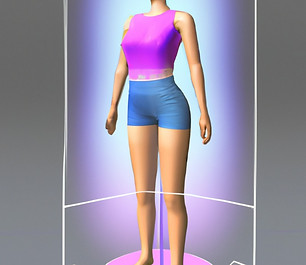
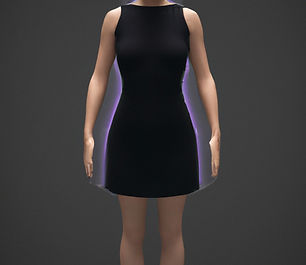
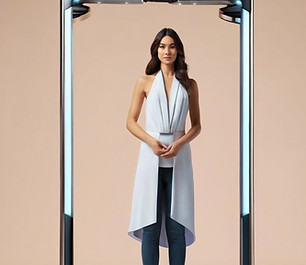
In the apparel industry, 3D body scanning has been extensively used for anthropometric studies of various populations. Traditional sizing systems used standard measurement definitions and disregarded the posture of the body. Older women, for example, may have the same/similar measurements as young women but will not fit into the same size because of a slouched posture. To create meaningful sizing tables, measurements have to relate to body shape and this can only be done with the help of body scanning technology (Dura´-Gil et al., 2019). The use of body scanning technology fostered numerous anthropometric surveys worldwide. The earliest of these was the Civilian American and European Surface Anthropometry Resource (CAESAR) project conducted in 1998–2000. The SizeUK project (1999-2002) scanned 11,000 men and women using full-body scanners. The surveys conducted have led to the availability of good quality anthropometric data, something that was rare at the time. Another interesting application of 3D body scanning is kinanthropometry (measuring a body in motion) or body motion analysis. Protective gear such as firefighting, military, or sportswear is used under extreme conditions and postures required for various activities, such as gymnastics, motorcycle riding, or soldier (Gupta, 2020). The lack of a good fit in such clothing can compromise safety and performance. A 3D scanner is used to capture motion data by scanning the body in static poses and during movement. These ‘4D measures’ yield various data like mapping the change in body length and girth with movement (to design sports and protective clothing). 3D body scanning technology is currently viewed as the frontier in solving fit problems, for instance, by generating accurate data for the development of size charts, enabling a pragmatic approach to offering mass customization, and facilitating virtual model fit trials that enhance online clothing shopping experiences (Apeagyei, 2010). 3D body scanners are also used in the manufacture of dress forms as well as to study body shape variations, e.g., a lingerie company used 3D scans to visually identify different bust shapes and configurations in the population. Designers analyzed which shape variations had an impact on bra fit and made decisions about styles that are optimized for different women (Ashdown, 2020). Apparel brands use 3D body scanning technology to provide personalization to customers through custom-fitted clothes. Instead of using a measuring tape, precise measurements can be obtained from 3D body scanners. Major industry players like Brooks Brothers, Lands End, and Levi’s used 3D body scanners to create customized garments and novel pattern development techniques in the initial years when body scanning was still a new and exciting development. Nowadays fashion brands use 3D body scanners in their trial rooms to help customers try on clothes in different colors with matching accessories without undressing or leaving the room. Online fashion brands use virtual fitting rooms in their apps to help customers get the right fit/size and to avoid the cost of returned merchandise. Customers can upload their 3D avatars and ‘try-on’ clothes. Amazon acquired Body Labs in 2017 so that it could offer better-fitted clothes and shows to its customers. Bodi.me uses 3D body scanning and describes itself as a 'pioneer in clothing size and fit optimization since 2014’. Scanners themselves have changed on the one hand from large, expensive stationary installations to smaller affordable units on tripods or handheld devices and on the other hand to multiple sensor installations that can capture the full 3D body in motion in high resolution and with great precision. The earliest scanners, like the one used in the CAESAR project, were composed of six cameras with a booth dimension of 3mx3mx3m, weighing 450 kgs and costing US$350,000. It took weeks to stitch the scans together to make the 3D form. A variety of portable, easy-to-use scanners has come onto the market since that time that cost between $20,000 to 30,000, weigh 30-40 kgs and take a scan in about a minute with the '4D measures' generated in real-time.
Check Out the Link Below:
Process of Scanning
‘3D human scanning is a process of capturing and subsequent digitization of the full body or the body parts into their three-dimensional graphical representation’ (Arbutina et al., 2017). Any device that uses lasers, lights, or x-rays to measure and generate data in the form of dense cloud points can be considered a scanner. Scanners consist of a light source, sensing devices, software to assemble the scan from the data of the sensing devices and software to extract information from the assembled scan (Ashdown, 2020). 3D body scanners capture and plot points from the surface of the body generally in a grid density of 2mm x 2mm. These points create a statue-like rotatable image. The scanned data vary in the amount of post-processing required as scanners create redundant points. The software developer generates the program to assemble and justify these redundant points to create a digital model that will have the same measurements and shape of the organic body. The process of generating body dimensions is distinct from the process of creating a 3D digital body. Scanning systems automatically derive the linear measurements from the scan, but the algorithms used by different companies vary and hence scanners that generate the best scan may not have the best automatic measuring system for that project. Thus, it is possible to scan in one system and derive measurements in the other. The video below, 'Artec Leo: 3D Scanning Statues', demonstrates the process of scanning.
The following video explains the process of 3D scanning.
Source.Solidxperts | By SolidXperience (2022)
Technologies
Various technologies are used in 3D body scanners and the field is evolving. The main distinction is the use of the light source, which interacts with the sensors used to collect data (Ashdown, 2020).
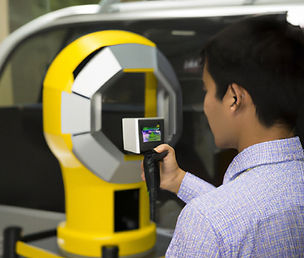
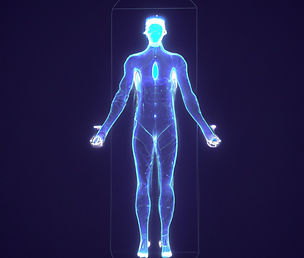
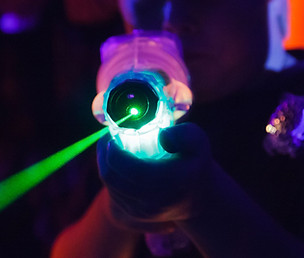
Given below is a table with a comparison between the features of laser scanners and structured light scanners (the 2 main types of scanners used in 3D body scanning) followed by brief descriptions of all 5 types of scanners, including (1) Laser Scanners, (2) Structure Light Scanners, (3) Millimeter-wave Scanners, (4) Infra-red Scanners, and (5) Four-dimensional Scanning (3D Scans in Motion).
Table
The Features of Laser Scanners and Structured Light Scanners
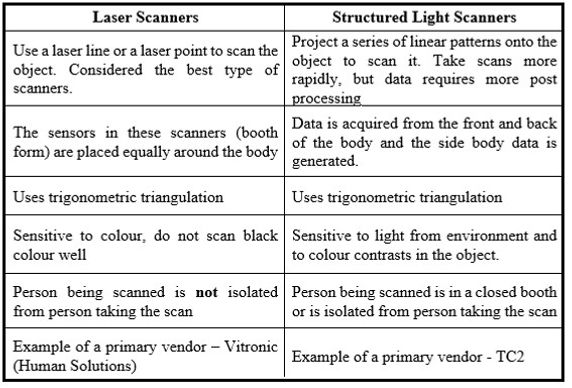
Source. Ashdown (2020)
Brief Descriptions of Five Types of Scanners
(1) Laser Scanners: These scanners are considered the best. These scanners scan the subject using a laser line or a laser point. The sensors in these scanners (booth form) are placed equally around the body. A sensor picks up the laser light that is reflected from the object and using trigonometric triangulation, the system calculates the distance from the object to the scanner (Arbutina et al., 2017). Laser scanners are sensitive to color and will not scan black color objects well. This can be adjusted at the cost of speed of scanning (generally 12 seconds). Scanning can occur in the presence of white light so the person being scanned is not isolated from the person scanning. Vitronic (Human Solutions) is a major company providing laser scanning. (2) Structured Light Scanners: These scanners use the trigonometric triangulation but instead of using laser light, they project a series of linear patterns onto the object. This video is informative of the scanners. They scan more rapidly than laser scanners but the data obtained may require greater post-processing. These scanners take multiple scans and then use algorithms to construct the 3D digital model. The data is acquired from the front and back of the body and the side body data is generated as part of the data assembly process. White-light scanners can be very sensitive to color contrasts in the object being scanned. These scanners are sensitive to external light and the scanning space must be isolated from the environment, blocking the view of the person being scanned from the researcher. This can be a problem as the posture of the person being scanned cannot be monitored as the study participant is in a closed booth. TC2 is one of the major vendors of structured light scanners. (3) Millimeter-wave Scanners: These scanners use non-visible wavelengths that can travel through clothing and scan the body. These are used at airports where the subject can be fully clothed. They are also used for size-selection in malls. (4) Infra-red Scanners: Infra-red scanners also use non-visible wavelengths but cannot scan through clothing. This technology is often used in hand-held scanners. These scanners are relatively recent and are more affordable. Though their scan resolution cannot match the stationary scanners, the technology is rapidly evolving. (5) Four-dimensional Scanning (3D Scans in Motion): Full-body 3D scans are taken with multiple cameras in a stereophotogrammetry process. Photogrammetry is a process of taking many pictures of an object at once and from different angles and then processing them to ‘stitch’ them together to create a 3D scan. The technology allows for capture of body movement in 3D over time. The scanners deliver high-quality, coloured and textured body scans but has a high cost. There is not yet a clear understanding of their use in the apparel industry.
Issues in 3D Body Scanning
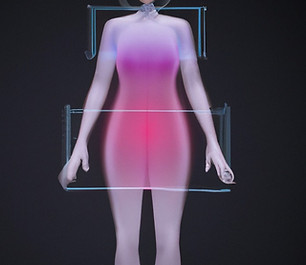
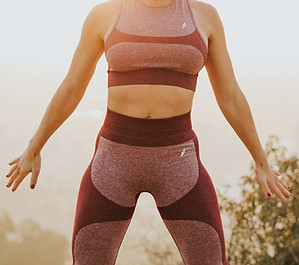

The hardware of the scanner and characteristics of the subject being scanned shed light on various aspects of the scanning process, including (1) Calibration, (2) Scan Time, (3) Posture, (4) Scanning Hair, (5) Apparel during Scanning, and (6) Landmarking. (1) Calibration: Most scanners require an initial calibration process to align and coordinate sensors and periodic calibration to correct any drift. (2) Scan Time: Scan time is optimized for the amount of time an unsupported person can stand still without starting to sway and most scanners are designed to collect the data for the scan in 3-12 seconds. Scan time can increase if a higher resolution is desired. (3) Posture: Posture is a critical issue in scanning. Most scanners require their subject to stand with feet shoulder-width apart, with their arms abducted from their body. If care is not taken to coach the subject about taking a relaxed position, the subject may, for example, brace his/her shoulders back or lock his/her knees which may affect the validity of the measurements from the scan. (The anthropometric position - head in the Frankfort horizontal plane, shoulders relaxed, arms at the sides, hands relaxed and facing forward, and feet with heels together and toes at a 60-degree angle) is ideal for reliable measurement data but this position obscures sensors from parts of the body like underarms, crotch, and inner thighs, especially for overweight subjects. The ISO standard for scanning metrics for anthropometrics includes one standing anthropometric position and one standing position with abducted limbs. (4) Scanning Hair: Scanners do not capture the top of the head well. Light sources may be scattered in hair, impacting the scan quality. The best practice is to cover the hair with a close-fitting cap or tying the hair (if it is very long) up on top of the head. (5) Apparel in Scanning: Clothing is important to provide a sense of modesty and to provide consistency among the subjects. It may also be important to scan the study participants’ in their regular underwear, only providing scan clothing for cases where the underwear is unsuitable (many scanners will not scan black underwear). For apparel studies of women, scanning the subject in their most commonly worn bra will provide a more valid breast shape than the more relaxed sports bras that have commonly been used in scan studies. (6) Landmarking: The first step in generating a measurement from a scan is to identify the points on the body to be measured, or the body landmarks. Because there is great variation among body shapes, it is difficult to place landmarks reliably. It is even more difficult to design software to place landmarks on body scans. For example, the ‘natural’ waist is defined as the level of the spine of highest articulation. But this point may not be the same for all body shapes. For men, there may be a bulge at this point of highest articulation. Most scan software provides a variety of choices for waist placement. Sometimes it is necessary to place landmarks manually and marking the landmarks that are critical and cannot be reliably located automatically.
The 2-minutes video tutorial below, which explains how to scan, provides valuable information and explanations about the entire scanning process.
Source. Tracy & Tom Hazzard (2019)
3D Body Scanner Examples
A few models of 3D body scanners are discussed in this section. The specifications of the models is reproduced from Aniwaa.com, a popular website for information and evaluation of 3D scanners. Examples of 3D body scanner are (1) Vitus 3D Body Scanner from Vitronic, (2) Texel Portal MX from Texel, and (3) Artec Eva from Artec. (1) Vitus 3D Body Scanner from Vitronic: Vitronic is one of the established brands in 3D scanning. This body scanner uses laser triangulation technology. The scan process includes a laser line and a camera looking at the laser line. 3D sensors move vertically during the scan process to capture high resolution images in a few seconds. The applications of the scanner include making 3D figurines, in the fashion industry for made-to-measure clothing, in the healthcare and fitness industries, and for creating avatars for use in AR/VR. (2) Texel Portal MX from Texel: The Texel Portal MX is manufactured by a Russian company and is an upgrade from their original model Texel Portal. It uses structured light scanning technology. Its main features include scanning time of 30 seconds, can scan 40 people in one hour, 3D model can be prepared in five minutes, weighs 55kg and does not require any calibration. It can provide 100 plus accurate body measurements. It comes with a rotating platform, a high-performance windows PC and a tablet PC. (3) Artec Eva from Artec: The Artec Eva is a hand-held structured light scanner that can scan the full human body with high accuracy. The company claims that it has been used for the presidential portrait of Barack Obama. 3D body scanners are available in many varieties of models – from rotating podium types to easy-to-use handheld types. The price range of 3D body scanners is as vast as $500 to $250,000. The end use of the scanner determines the most suitable model to purchase. While 3D body scanners are available as an equipment, the option of 3D body scanning is available now through common phone cameras, as software and applications have been developed to process the multiple images taken by the phone camera. Photogrammetry applications like Meshroom and Blender can help create 3D scans of objects and people from photographs taken with a phone camera.
Check Out the Links Below to Learn More About Latest 3D Body Scanners:
The Future
Body scanning technology has made it possible for fashion companies to have access to data about body size and shape. Understanding and analyzing body size data can help companies cater to their target group of customers, instead of drawing from standard sizes. Brands can target specific demographics e.g., the plus-size market. Companies like Alvanon collect data from body scanning and work with fashion brands to help them develop the right fit for a specific demographic like the plus-size market. Online retailers typically struggle with a high rate of return. The market has responded with solutions like those provided by True Fit that help the consumer choose the right size. A similar solution is offered by Virtusize. However, these technologies don’t solve the fit problem fully because fit is about 3D shapes. ‘Fitting a garment on a friend who has the same measurements may help with choosing the size but says little about the actual fit on the intended person, in physical or virtual reality’ (Dura´-Gil et al., 2019). The solution requires simulation technology as exhibited by virtual prototyping companies like Optitex and CLO. These technologies are unfortunately only available to skilled professionals. The challenge is to bring this technology to the everyday consumer. Companies like CLO are working on commercial, easy-to-use applications that would allow a consumer to simulate the fit of an actual garment on their own digital body. Digital measuring methods can accurately search for geometric references on the body to extract measurement and machine learning techniques can be used to automatically identify or predict anatomical landmark locations. Data-driven approaches have been successfully used to reconstruct 3D bodies from photographs of subjects. The accuracy of measurements from these 3D avatars reconstructed from a photograph gathered from a smartphone application are slightly less precise than high-end body scanners, but provide a realistic and visually accurate 3D avatar, making them an affordable alternative to fit, size, and style recommendations. These data driven reconstruction methods are paving the way for the next generation of affordable 3D body capturing devices (Dura´-Gil et al., 2019). These technologies will also have to be easy to use and comfortable for the person being scanned as well as for the person taking the scan. The issue of privacy as a deterring factor for 3D body scanning cannot be ignored. The requirement of being scanned in underwear is a potential risk factor, as this data can be misused if it is not kept confidential.



Consumer Perceptions of 3D Body Scanning
An important factor to discuss is the psychological effects that a 3D body scan can have on the consumer. A study published by Ridgway (2018) found that when people view their 3D scans, they often have negative feelings about their appearance. In the study, the participants’ perceptions of their bodies before and after they viewed their 3D body scans had altered. Most of them perceived their size to be larger after viewing their body scans. Retailers who plan to use body scanning as part of the customer experience need to take note that these emotional changes can affect shopping behavior. Another study (Grilec et al., 2019) highlights the differences in attitude toward 3D body scanning and intention of using 3D body scanning in internet shopping across consumers with different body types. Respondents were divided into 3 groups according to body sizes. While most respondents in Group 1 (group with smallest body sizes) felt that 3D body scanning was fun, interesting, and futuristic, respondents form Group 2 and 3 (group with larger body sizes) did not agree to the same extent. Further, while respondents from Group 1 agreed that they would like to use their 3D scanned model for online shopping, would be willing to pay higher prices for apparel that is adapted to their body measurements, and would be willing to wait longer for its delivery; respondents from Group 2 agreed but to a lesser extent. Finally, respondents from Group 3 (group with largest body sizes) were not interested in using their 3D body scanned model for online shopping. The study concludes that different marketing approaches are required for consumers of different body sizes. An earlier study on the attitude of older women towards 3D body scanning revealed that ‘No clear correlation of age and comfort with body scanning was found; however, frequency distributions and qualitative comments did indicate possible patterns of less comfort and interest among older individuals’ (Lee et al., 2011). A mixed method approach applied to gauge women’s long-term reactions to whole-body scanning concluded that whole body scanning should be used with caution, particularly for women with existing body concerns (Grogan et al., 2016). Further, the user experience of the 3D body scanning device should resonate with how and why fashion is consumed and a home webcam/camera 3D body scanning service will be better able to fulfill the customer’s individual needs of function, convenience, privacy, cost and entertainment (Peng et al., 2012). While 3D body scanning technology is progressing at a rapid rate, fashion retailers and technology companies catering to fashion brands need to take into account the results of the growing number of studies on consumer perceptions of 3D body scanning.
References
Apeagyei, P. R. (2010). Application of 3D body scanning technology to human measurement for clothing Fit. International Journal of Digital Content Technology and its Applications, 4(7), 58–68.
Arbutina, M., Dragan, D., Mihic, S., & Anisic, Z. (2017). Review of 3d Body Scanning Systems. Acta Technica Corviniensis-Bulletin of Engineering, 10(1), 17–24.
Ashdown, S. P. (2020). Full body 3-D scanners. In N. Zakaria & D. Gupta (Eds.), Anthropometry, Apparel Sizing and Design (pp. 145–168). Woodhead Publishing.
3D body scanners. (n.d.). Bodi.me. Retrieved September 11, 2021, from
https://bodi.me/3d-body-scanner/
Dura´-Gil, J. V., Kozomara, Z., Ballester, A., Solves-Camallonga, C., & Pierola-Orcero, A. (2019). Clothing. In S. Scataglini & G. Paul (Eds.), (pp. 599–612). Academic Press.
Fast 3D scanner for professionals (n.d.). Artec3D. Retrieved September 11, 2021, from https://www.artec3d.com/portable-3d-scanners/artec-eva
Grilec, A., Petrak, S., & Naglic, M. M. (2019). Consumer perception of 3D body scanning while online shopping for clothing. International Journal of Humanities and Social Sciences, 13(7), 1037–1042.
Grogan, S., Gill, S., Brownbridge, K., Warnock, D., & Armitage, C. J. (2016). Women’s long-term reactions to whole-body scanning: A mixed methods approach. Clothing and Textiles Research Journal, 34(1), 61-73.
Gupta, D. (2020). New directions in the field of anthropometry, sizing and clothing fit. In Anthropometry, apparel sizing and design (pp. 3-27). Woodhead Publishing.
Lansard, M. (2022, March 25). The 6 best 3D body scanners in 2023. aniwaa. https://www.aniwaa.com/buyers-guide/3d-scanners/best-3d-body-scanners/
Lee, Y.-A., Damhorst, M. L., Lee, M.-S., Kozar, J. M., & Martin, P. (2011). Older women’s clothing fit and style concerns and their attitudes toward the use of 3D body scanning. Clothing and Textiles Research Journal, 30(2), 102–118.
MelSimba. (2019, December 11). Laser Scanning triangulation diagrams - why is laser always perpendicular to surface?. Reddit. https://www.reddit.com/r/Physics/comments/e9e7lh/laser_scanning_triangulation_diagrams_why_is/
Partner. (2020, April 20). Could body scanning be the future of fashion? Industry innovator Alvanon believes so. Fashionunited. https://fashionunited.uk/news/business/could-body-scanning-be-the-future-of-fashion-industry-innovator-alvanon-believes-so/2020042048540
Peng, F., Sweeney, D., & Delamore, P. (2012). Digital innovation in fashion how to “Capture” the user experience in 3D body scanning. International Journal of Industrial Engineering and Management, 3(4), 233–240.
Portable 3D scanners (n.d.). Artec3D. Retrieved September 11, 2021, from https://www.artec3d.com/portable-3d-scanners
Ridgway, J. L. (2018). Before and after avatar exposure: The impact of body scanning technology on body satisfaction, mood, and appearance management. Clothing and Textiles Research Journal, 36(2), 91-103.
Solidxperts | By SolidXperience. (2022, September 13). Artec Leo: 3D scanning statues. [Video]. YouTube. https://www.youtube.com/watch?v=prVNwToBnn4
TevasTop Comm. (2018, September 27). 3D scanning your body using smartphone camera|3D printing & cloning services. [Video]. YouTube. https://www.youtube.com/watch?v=Bbxhie_q9Lo
Texel Portal – A rapid, reliable and precise 3D scanner. (n.d.). Texel. Retrieved September 11, 2021, from https://texel.graphics/
Tracy & Tom Hazzard. (2019, January 22). Artec3D scanning hardware and software demo. [Video]. YouTube. https://www.youtube.com/watch?v=2n0uJ_5niCQ
True Fit® | True Fit®Data-driven personalization platform for fashion retailers. (2020). Truefit.com. https://www.truefit.com/about
Virtusize. (n.d.). Www.virtusize.com. Retrieved September 11, 2021, from https://www.virtusize.com/virtusize
Vitus 3D body scanner. (n.d.). Aniwaa. Retrieved September 11, 2021, from https://www.aniwaa.com/product/3d-scanners/vitronic-vitus-3d-body-scanner/
Who we are. (n.d.). alvanon. Retrieved September 16, 2021, from https://alvanon.com/





